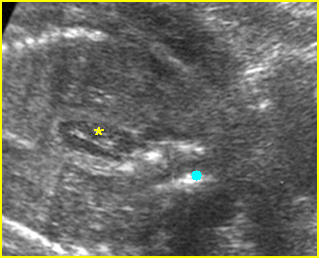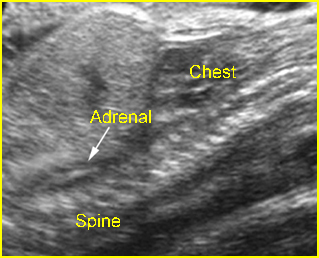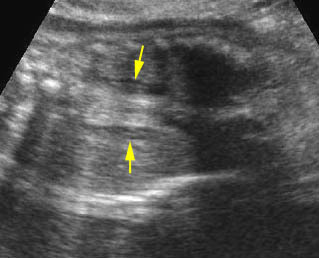Bilateral Renal Agenesis
Renal agenesis is the absence of one or both kidneys, resulting from unilateral or bilateral failure of development of the ureteric bud secondary to multicystic dysplastic kidney. Bilateral renal agenesis combined with fetal deformities secondary to oligohydramnios (pulmonary hypoplasia, abnormal facies, and abnormal limb postures) is called Potter’s syndrome.
Incidence: Unilateral renal agenesis occurs in 1 per 1000 births (male/female; 1:1) whereas bilateral agenesis is a lethal anomaly, sporadically occurring in 1-4 per 10,000 births with a male to female ratio of 2-3:1.
Sonographic findings:
- Non-visualization of kidneys and bladder.
- Oligohydramnios in the second trimester, however, amniotic fluid can be relatively normal at up to 16 weeks of gestation.
- Adrenal glands filling the renal fossae, producing the lying down adrenal sign. Fig 1, Fig 2
- Absence of both renal arteries using color-flow Doppler imaging.
- Compression effects such as dolichocephaly and small thorax. Fig 2
- Careful scanning is required before making the diagnosis because the absence of amniotic fluid degrades the sonographic image.
- Potential pitfalls in the diagnosis include
- There is an inability to image the kidneys and bladder due to the poor image quality secondary to severe oligohydramnios; amnioinfusion may be helpful in this case. Color flow is also helpful in demonstrating renal vasculature to confirm the presence of kidney.
- In the absence of kidney, the ipsilateral adrenal is often flattened or lying down and is mistaken for a kidney. Note that the adrenal gland has no central sinus echoes and no reniform shape in the longitudinal view.
- Pelvic kidney: It is important to scan the fetal pelvis to be sure that the kidney is truly absent rather than in an ectopic location.
- Crossed renal ectopia may be mistaken for unilateral renal agenesis. In this case, the united kidney is bilobed, enlarged and often with findings of obstruction.
- Usually first diagnosable in the early second trimester, at 15-18 weeks.
- In case of inconclusive findings, MRI is usually helpful.

Fig 1: Bilateral renal agenesis Coronal scan of the abdomen: absent kidneys with oligohydramnios and adrenal gland replacement (*) (solid circle = spine)

Fig 2: Bilateral renal agenesis Sagittal scan of the abdomen: absent kidneys with oligohydramnios and adrenal gland replacement (arrow)
Video clips of bilateral renal agenesis

Bilateral renal agenesis: Coronal scan of the abdomen, no visible kidney, oligohydramnios, elongated adrenal glands (arrow) seen in the renal fossa instead
Associations: About half of the cases may have anomalies of other organ systems; all systems can be involved.
Management: Termination of pregnancy can be offered. Vaginal delivery without electronic fetal monitoring in labor is appropriate.
Prognosis: Fatal for bilateral agenesis but excellent for unilateral agenesis.
Recurrence risk: Sporadic with rare autosomal dominant inheritance.

